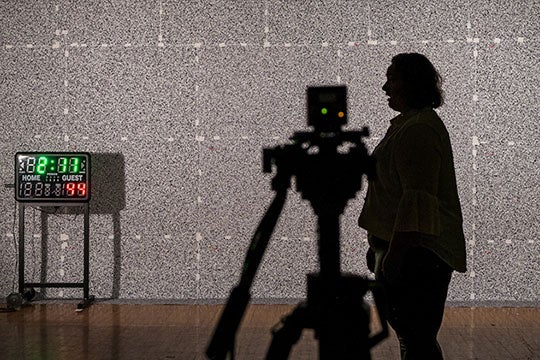
Safety Onstage
A study of exhaled aerosols points to the importance of ventilation for performance artists.
By Jade Boyd
Keeping musicians safe while they’re onstage during the pandemic may require more than just social distancing, according to a study of exhaled aerosols conducted by Rice engineers and musicians from the Shepherd School of Music and the Houston Symphony.

In August, engineers from the lab of Ashok Veeraraghavan used a high-speed camera and computational imaging to track the movements of exhaled air released by singers and musicians who play wind instruments. The experiments showed that much of the air exhaled by performers, even those playing instruments, tended to rise toward the ceiling and join air currents created by the room’s air-conditioning vents.
With musical organizations around the world making plans for seasonal performances, Veeraraghavan and the study’s other principal investigators, Shepherd School Dean Robert Yekovich and Houston Symphony CEO John Mangum, moved quickly to analyze the data and publish their findings, recommendations and source data online in advance of peer review. Yekovich said it was “imperative to make others aware of what we found.” The research was funded by a grant from Rice’s COVID-19 Research Fund, and Veeraraghavan said the hypothesis going into the study was that exhaled airflow in front of singers and instruments would be the critical factor for determining social distancing guidelines.
Using a form of schlieren imaging, a decades-old technique for filming airflow, postdoctoral research associate Vivek Boominathan ’19 and others from Veeraraghavan’s lab filmed performers playing the flute, oboe, clarinet, bassoon, horn, trombone, trumpet and tuba, as well as a female and male singer. Using a combination of cameras, a specially printed high-resolution background and computational algorithms, Veeraraghavan’s team was able to visualize the direction and flow of exhaled air coming from the musicians’ instruments and mouths.
The video showed that exhaled air, which was warmer than room air, rose quickly. Veeraraghavan said the finding points to the importance of ventilation and the need for a tailored approach for keeping audiences and performers safe at specific musical venues. “Our main message is that there is no single silver bullet,” he said. “Performance venues are going to need a mix of several different risk mitigation strategies. Each of them will help a little, and the sum total of all of them will minimize risk to both the performers and the audience.”
The researchers recommended several strategies, including social distancing, wearing of masks and ensuring that ventilation systems meet or exceed federal standards. To see their full recommendations, analysis and data, visit tunesflow.rice.edu.
